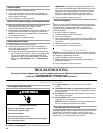
6
3. Starting with the right-hand side door, remove the parts for the
top hinge as shown in Top Hinge graphic. Lift the refrigerator
door from the bottom hinge pin.
4. Remove the hinge pin cover from the bottom hinge pin and
keep it for later use. See Bottom Hinge graphic.
5. Remove top hinge cover from left side refrigerator door.
6. Remove the façade from the front of the top of the cabinet.
Remove the screw on the backside of the center of the
façade, then slide the façade forward and out from under the
hinge.
7. Disconnect the wiring plug located on top of the hinge by
wedging a flat-blade screwdriver or your fingernail between
the two sections.
8. Disconnect the water line by pulling back on the locking collar
while pulling the water line out of the water line connector.
9. Remove the parts for the top hinge as shown in Top Hinge
graphic. Lift the left-hand side door from the bottom hinge pin.
NOTE: On some models, remove the hinge pin cover from the
bottom hinge pin and keep it for later use. See Bottom Hinge
graphic.
10. Using a ³⁄₈" hex wrench, remove the leveling leg brackets from
the bottom of the cabinet. Keep screws for later use.
Replace Doors and Hinges
1. Assemble the parts for the top hinges as shown in Top Hinge
graphic. Do not tighten the screws completely.
2. Replace the parts for the bottom hinge as shown in Bottom
Hinge graphic. Tighten screws. Replace the refrigerator door.
NOTE: Provide additional support for the refrigerator door
while the hinges are being moved. Do not depend on the door
gasket magnets to hold the door in place while you are
working.
3. Align the door so that the bottom of the refrigerator door
aligns evenly with the top of the freezer drawer. Tighten all
screws.
4. Reconnect the wiring plug on top of the left-hand side
refrigerator door.
5. Reconnect the water line by pulling back the locking collar
ring while firmly pushing the water line into the connector.
6. Check for leaks. Replace the façade and top hinge covers.
Remove and Replace Freezer Drawer
IMPORTANT: Two people may be required to remove and replace
the freezer drawer. Graphics are included later in this section.
Remove Drawer Front
1. Open the freezer drawer to full extension.
2. Loosen the four screws attaching the drawer glides to the
drawer front. See Drawer Front Removal graphic.
NOTE: Loosen screws three to four turns. Keep the screws in
the drawer front.
3. Lift drawer front upward and off the screws. See Drawer Front
Removal graphic.
Replace Drawer Front
1. Slide the drawer glides out of the freezer compartment. Insert
the screws in the top of the drawer front into the slots in the
drawer brackets. See Drawer Front Replacement graphic.
2. Pull the drawer brackets toward you to position the two
screws in the bottom of the drawer front into the brackets.
See Drawer Front Replacement graphic.
3. Completely tighten the four screws.
Adjust the Doors
There are two leveler foot screws located at the base of the
refrigerator. If your refrigerator seems unsteady or you want the
door to close more easily, use the following instructions.
1. Using a ¹⁄₄" hex driver, turn the leveling screw on each side to
raise or lower that side of the refrigerator.
NOTE: Having someone push against the top of the
refrigerator takes some weight off the leveling screws which
makes them easier to turn. It may take several turns of the
leveling screw to adjust the tilt of the refrigerator.
■ To raise, turn the leveling screw clockwise.
■ To lower, turn the leveling screw counterclockwise.
2. Open the door again to make sure that it closes as easily as
you like. If not, tilt the refrigerator slightly more to the rear by
turning both leveling screws clockwise. It may take several
more turns, and you should turn both screws the same
amount.
3. Replace the base grille.
Final Steps
1. Plug into a grounded 3 prong outlet.
2. Return all removable parts to doors and drawer and food to
refrigerator and freezer.
A.Leveling screw
A
Electrical Shock Hazard
Plug into a grounded 3 prong outlet.
Do not remove ground prong.
Do not use an adapter.
Do not use an extension cord.
Failure to follow these instructions can result in death,
fire, or electrical shock.
WARNING


















